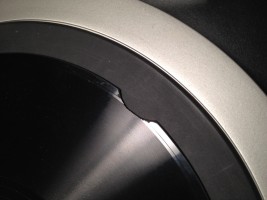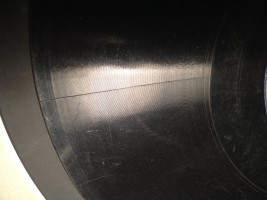This post offers some simple tips to help collectors extend the life of analog recording media and prioritize their preservation for the long term.
We live in a lucky time: we have sound recordings available to us at our very fingertips. Recorded sound surrounds us, and recordings – spoken or sung – are an almost passive part of our culture.
These days we’re always awaiting the latest upcoming audio technology which transforms our listening experience every time, but imagine the earliest days of recorded sound. Imagine hearing that very first recording, a preserved moment, a voice. With each innovation of audio technology, the integrity of our culture and history became pressed upon a wax cylinder (or wire or platter or a compact disc or an audio file on our computer). This is our cultural history now.
According to Firstounds.org, the first recorded sound was used for visual purposes – to observe the shape of a wave form – in 1860 by Édouard-Léon Scott de Martinville and could not be played back at the time. In 1877, Thomas Edison introduced his phonograph cylinder technology, which allowed for playback. Audio technology has evolved to include a constantly expanding list of formats. (We’re now able to capture audio using a high speed camera without a microphone!) With the invention of digital audio, we recognize a need to preserve those previously recorded analog sounds. The recordings are not necessarily becoming obsolete, but devices to play back some of those recordings are. (Cylinder technology is nearly 140 years old; wire technology is over 70 years old.) And the media on which those recordings exist is rapidly degrading.
Fortunately, we can preserve our cultural history through digitization that ensures that even when the physical media is no longer playable, we have a digital copy of the material. However, the window to salvage old analog media is closing quickly. According to the Library of Congress National Recording Preservation Plan, published in 2012, “many analog audio recordings must be digitized within the next 15 to 20 years before sound carrier degradation and the challenges of acquiring and maintaining playback equipment make the success of these efforts too expensive or unattainable.”
Adopt simple storage and handling techniques to avoid damaging your analog recordings
The Library of Congress goes to extreme measures to keep their archives from deteriorating. Even in a home or business setting, we can look to their methods to keep our own analog collections in the best shape possible.
Storage:
• Temperature: The LoC keeps their facilities at a cool 50 degrees Fahrenheit, with 30 percent humidity. Many companies looking to keep their technology, computers, and IT systems at a suitable temperature to prevent them from overheating, causing significant damage to their data and equipment, will often consider refrigeration and air conditioning solutions to help them maintain the temperature. Check out Solaranlage.com – Air Conditioning Technology for more information on the subject. If you don’t have a room that you can keep at this state.
• Avoid severe temperature swings and poor ventilation. Don’t allow your media to freeze as this may cause brittle breakage, and don’t let it overheat. A hot attic can lead to warping, breakage, or delamination (the shedding of magnetic material from the tape surface), but a cool crawl space may be too damp which can lead to mold or fungus growth. Getting an electrician like those at https://saltle.com/ to install a ceiling or extractor fan in your storage area can help with humidity and temperature regulation. This is especially useful in storage areas where air conditioning units are unsuitable for installation.
· Store upright (that’s up on its side for all media – reel-to-reels, records and cassettes). Play-wind your tapes so the the tape pack is smooth, without any easily-damaged protruding tape layers. Open reel tapes should be stored “tails out” so they must be rewound before playing. Investing in proper storage shelves is a must as it allows for the media to be stored properly.
· Make sure your storage space is sturdy. A collapse can break fragile media. This might be worth keeping in mind when learning how to Build the Ultimate Home Theater so you can accommodate your analog media collection including your more modern media and devices.
· Avoid light exposure. Light transfers heat which as explained before can damage the tape. In addition, strong sunlight can bleach and denature tapes, reducing their quality.
· Avoid spilling anything on the media. Keep food and liquids away
· Avoid magnetic fields (for magnetic media such as reel-to-reels and wire recordings).
· Avoid vibration. This can lead to instability of shelving, breakage or, for reels, wear on the winding of the tape.
Handling:
· Avoid overplaying. Overplaying or playing on a non-optimized device (for example, using the wrong disc stylus) can wear out the media and make it susceptible to damage (groove scoring, tearing, breakage), leading to permanent loss of the recorded material. Make sure to always use a properly optimized device for any playback you wish to do.
· Keep your playback equipment clean and maintained.
· Allow the media to acclimate to the room temperature before playback.
· Handle your media with extra special care. Wash and dry your hands before handling and don’t touch the playing surface. Grooved discs, such as vinyl LPs and 45’s, 78’s and lacquer discs should be handled only by the edge and label areas. Optical discs should only be handled by the edge and center hole. Avoid contact with or friction on the recording surface. (For grooved discs, this would be the grooves.) For optical media (CDs, DVDs, etc.) make sure the disc is supported by the center hub of the jewel case. Never stack discs that are not in their cases!
Safely access the content on your old recordings
For long-term access, digitization is the answer. For most collections, digitization is also a long-term project, so it’s important to set priorities for digital conversion.
1. Do you have playback equipment for the format? Remember that new analog tape machines have not been manufactured for many years. This is also true for cassette machines. Existing machines require periodic maintenance, alignment, and head replacement. Playing back a valuable recording on a machine that was poorly maintained will give unsatisfactory results and could also damage the tape. Playback machines should be aligned for each transfer. There are many obsolete analog and digital recording formats, and the machines needed for transferring these recordings are getting scarcer and harder to maintain. Transferring these recordings should be a high priority.
2. Do the recordings already show signs of degradation or environmental damage? Each recording format has its own unique challenges and forms of degradation, but here are a few common examples of what to look for:
-Mold, mildew, fungus (these are contagious so be sure to isolate any boxes or media showing mold, mildew or fungus)
– Delamination (the coating that holds the recorded grooves starts to peel off of the base material; in magnetic media it’s also known as “shedding”). Check out photos of this here.

– Curling & warping
– Scratches
– Oxidation
– Binder breakdown
– Breaking or chipping of rigid media
– Shrinking
– Wear from overplaying
If the media is already showing signs of degradation, consider making it a high priority for digital conversion.

If you’re uncertain about the type of degradation you’re seeing, send me a photo; I’m happy to help.
3. Is the recording something you really want to listen to?
Even if you have the means for playback, it may not be the wise thing to do. Many older recordings may be susceptible to damage and degradation from playing. Even a cassette recording can be damaged if not properly played back. The safest way to access the content is to carefully digitally transfer the material. Having a high-resolution digital copy ensures that you will be able to access the content, since digital files don’t degrade, no matter now many times you listen to them. It may be too soon for us to know if digital files really will always be usable, but for the meantime, your favorite recordings can be modernized in a way that future technologies will be able to handle, where the original medium may be unusable.
Airshow’s Digitization Resources
Digitization is the best answer to our preservation issues: The rate of degradation on digital archives is vastly slower than that of older media. Digitization along with other backup and archival processes ensures that the sound isn’t lost completely. Since making copies of digital files is non-destructive, we can continue to preserve the digital files into the future even as storage media evolves.
Like the Library of Congress, the Airshow Restoration Center maintains equipment capable of playing back many formats of recorded media. Airshow’s machines are pro audio grade and fully maintained. Even if you can’t find that old tape machine, chances are we have one that can play your tape back (or we know someone who can). It’s rare that we come across a format we haven’t seen before, but when we do, we’re just as intrigued as you are!
Many audio collections are truly mysteries to those who hold them. Airshow offers Discovery Day sessions to help decode the mysteries. With a full suite of legacy playback equipment and professional engineers who adhere to digitization methods and standards set by the Library of Congress, we can assess your media and give you a realistic look at the state and quality of your treasures, to help you plan their preservation for future generations to cherish.
Further Reading
Media Storage Best Practices Table It describes best storage practices for many media types, and it also suggests how to prioritize the format for digitization.
Here’s an Airshow post on protecting your collection in disasters.
Also check out these other articles and websites about lost and found treasures:
Just How Much of Musical History Has Been Lost to History?, The Atlantic
IRENE Seeing Sound Blog, Northeast Document Conservation Center
